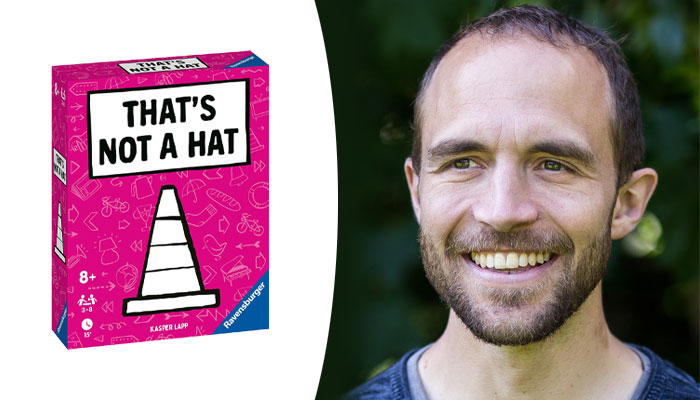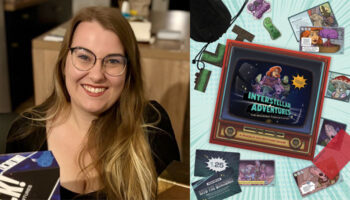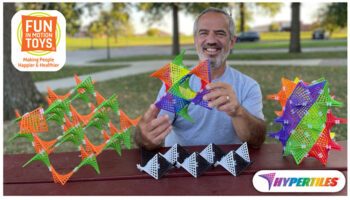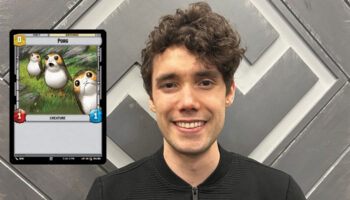Designer Kasper Lapp on creating a bluffing game for bad liars in That’s Not a Hat

Kasper, thanks for making time. The last time we interviewed you was way back in 2017 to discuss your first game, Magic Maze. Since then, you’ve had a whole raft of games published. Did the success of Magic Maze help pave the way for these?
Yes, it definitely made it easier to get meetings with publishers, but it didn’t make it easier to sell the games. They still have to be good. In some ways, I actually feel that Magic Maze came a little early in my game design curve – many of my other games from that time were not very good. I’ve become a better game designer over the years, or at least a better game developer.
And you’re a full-time game designer now?
Yes, I have been since Magic Maze – and it’s Magic Maze that I’ve been living off. So when people ask me “Can you make a living from game design?” I’ve always said “I don’t know, actually!”

Ha! Well, it’s a great game! Let’s dive into some of your new titles. First, I wanted to pick your brains on That’s Not a Hat, published by Ravensburger. I saw this at Toy Fair and thought it was a lot of fun. Essentially, it’s a card game where you’re receiving and giving gifts to each other, but there’s a memory element… Everyone sees what gift is on the card when a card is drawn, but you actually give cards to each other face down – so you have to try and remember who has what ‘gifts’. For example, if someone gives you a card and says: “I have a lovely hat for you”, but you don’t think there’s a hat on the card, you can reject it to make that person lose points. It’s a bluffing game as much as a memory game, right?
Yes! On the surface, it’s a memory game, but when you start playing, it becomes clear that it’s a bluffing game because no-one can remember all the presents that are being given. It’s all about sounding convincing when you give a present, so other players think you know what you are talking about. I don’t normally enjoy bluffing games because I’m not very good at lying, but here I’m not really lying… It’s more that I’m not completely sure if I’m telling the truth!
How did you come up with the game?
I actually feel I discovered it more than I invented it. When I made it, it was just supposed to be a little memory game… I thought perhaps it would be fun for kids. But when I tried it, I thought ‘Huh! This isn’t a memory game. It’s a bluffing game!’ I had the same experience as other people do when they play it!

What made Ravensburger a good home for it?
They were actually the first company I showed it to. They immediately ran with it and I think they did a really good job with it. You can’t quite call the box ‘pretty’, but it’s really recognisable, so that’s cool.
And a good name!
That’s Not a Hat was actually my name for it – although I didn’t think it would end up being the final name of the game!
Ha! It works. While I have you, I also wanted to discuss another one of your recent party game, Fun Facts published by Repos Productions. This co-op game sees players secretly answer a question – like ‘How long is the perfect nap? – before arranging those answers in order, lowest to highest. This is done without seeing anyone’s answers, so you have to guess how you compare to the other players. How did this one take shape?
Fun Facts actually came from a different idea I had. I had an idea for a game where you answer a question, but you have to ensure your answer falls in the middle of what everyone else has put. It wasn’t important what your real answer was, you were just trying to predict what everyone else would answer. It was okay, but because your answer wasn’t really your answer, it didn’t lead to interesting conversations between the players.

Interesting – and conversations are absolutely at the heart of Fun Facts, as players passionately explain why they fall in a certain place in the order of answers.
Absolutely. And that’s also why I think the quality of the questions is very important. Luckily, Repos did a great job with the questions. They did a lot of development and put a lot of work in to find out which questions sparked good conversations. It’s not something you can predict with certainty, you have to try them out.
You also have another party game that’s recently launched: Speak Easy. Here you’re trying to tell the other players the colour and shape on your card, but you can only speak in a nonsense-language. Sounds tough but fun!
There’s something inherently funny about speaking nonsense. It’s funny to hear someone try to seriously tell you something in a language that no-one understands.

We’ve spoken a lot about party games. Is this the area you find yourself naturally drawn to as a designer?
Not really… I’ve actually designed far more non-party games than party games, so maybe the reality is that I’m just better at party games – or maybe it’s that publishers are more interested in party games. I have three non-party games coming out later this year.
Is one of them Gardeners?
No, I’d class Gardeners as… Well, actually, it’s not quite a party game… It’s somewhere inbetween. It’s similar to Magic Maze in that some people would call it a party game, but others wouldn’t.
And it’s similar to Magic Maze in that Gardeners is also played in silence, in real-time. And it’s a co-op game too?
Exactly.
Did that make it a tougher sell? Was there a risk in publishers thinking it too similar to Magic Maze?
Well I haven’t actually made any silent co-op games in many years. I came up with Gardeners just after Magic Maze and it’s only coming out now. And it’s published by Sit Down, the publisher of Magic Maze.
The feeling is a bit like Magic Maze, but the gameplay is very different. To begin with, one player has their own goal. On the back of that player’s card is a flavour of what that goal is, so the other players have a sense of what that player might be trying to do. Then everyone works together to arrange a garden where the goal has to be fulfilled. If someone places a tile in the garden that doesn’t fit with your goal, you can’t move it somewhere better, you can only remove it and give it to another player.
In the hope that they place it somewhere more aligned to your goal.
Exactly. Each time you fulfil a goal, another goal is added. So eventually, every player has their own goal that they’re trying to simultaneously achieve. You really have to remember what you’ve learned about the other players’ goals.

Like it! And Kasper, what would you say is your most underrated game?
I have two! One is the Hidden Roles expansion to Magic Maze. I never really got much feedback on that and I don’t think it’s been very successful, but I really think it brings something new to the traitor game genre. It’s a bit like That’s Not a Hat in that you don’t have to lie to people, you just have to co-operate badly. The game is played in silence, so if you’re really bad at Magic Maze you’ll make for a good traitor!
We also included some roles in the game that make you seem like a traitor, even if you’re not. They force some behaviour that makes the other players suspect you. I thought that was a lot of fun, but it didn’t get much attention.

You’ve sold it to me – I’ll check it out! And your second pick?
God Loves Dinosaurs. I regret that it didn’t have more replayability.
How does that one play?
Each player gets their own little world where animals spawn and eat each other. Each turn, you take a tile from a column and place it in your world. That can give you terrain and a new animal, but it matters which column you take from because when it’s empty, that animal moves. So once the tiger column is empty, all the tigers move – which might be good or less good for you depending on your situation. If your tigers have loads of prey to eat it allows them to reproduce and spawn more tigers. But if the tigers have nothing to eat, they will die instead, so then you definitely don’t want to empty the tiger column.
The graphics and animal meeples are great, but the game didn’t have a lot of replayability. I’ve made a print-and-play expansion where you have different rules for different animals; a little like Cascadia.

Kasper, thanks for taking time out for this – I’ve got one more question! What fuels your creativity and helps you have ideas?
I often get ideas when I watch video reviews of other board games. They’ll highlight a detail that will spawn an idea for a game. Sometimes they identify an element of a game that’s been executed badly, and that also can spark ideas around how to make it better.
I’ve also gotten better at throwing game ideas away mid-way through the development process, once I’ve realised it’s not great. Of course, it’s very tough, especially when you’ve spent a long time on a game… But I suppose you learn something from those experiences, so it’s never a total waste.
Absolutely. Kasper, a huge thanks for this – and good luck with That’s Not a Hat!
–
To stay in the loop with the latest news, interviews and features from the world of toy and game design, sign up to our weekly newsletter here




















